£3m Surrey sensors will shine new light on why stars explode
Detectors that can stop very high-energy particles in their tracks and measure the speed at which reactions take place inside stars are being developed at the University of Surrey.

The £3.4m FAUST project, funded by UK Research and Innovation’s Science and Technology Facilities Council (UKRI-STFC), will develop detectors to sit inside the new GRETA gamma-ray array. This forms part of the $730m Facility for Rare Isotope Beams (FRIB) particle accelerator at Michigan State University (MSU), USA.
FAUST stands for “FRIB-Accelerated Beams for Understanding Science and Technology."
MSU operates FRIB as a user facility for the U.S. Department of Energy Office of Science (DOE-SC), supporting the mission of the DOE-SC Office of Nuclear Physics and a global user community of 1,800 scientists.

Almost all chemical elements like gold, oxygen, and iron are produced by nuclear reactions in stars. To learn more about where they come from, scientists need a deeper understanding of how these reactions take place.
Scientists will smash beams of speedy rare isotopes into various forms of plastic targets. By measuring the emerging light-charged particles (such as protons) that are produced, they hope to learn about the origins of elements from gold to oxygen and beyond.

The particles will be measured by a combination of silicon detectors, supplied by West Sussex-based Micron Semiconductor Ltd., and caesium iodide crystals, developed by colleagues at the University of York.
The UKRI-STFC Daresbury Laboratory in Cheshire will provide important technical support.
The device is due to be completed in 2028. It is expected to operate for at least 10 years.
Related sustainable development goals

Media Contacts
External Communications and PR team
Phone: +44 (0)1483 684380 / 688914 / 684378
Email: mediarelations@surrey.ac.uk
Out of hours: +44 (0)7773 479911
